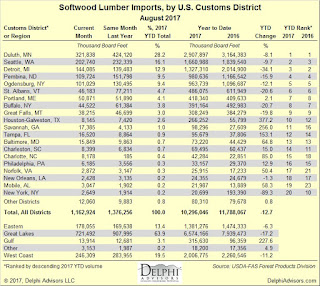Click image
for larger view
Click image
for larger view
Sales of new
single-family houses in September 2017 were at a seasonally adjusted annual
rate (SAAR) of 667,000 units (555,000 expected).
This is 18.9% (±19.0%)* above the revised August rate of 561,000 (originally 560,000
units), and 17.0% (±22.4%)* above the September 2016 SAAR of 570,000 units; the
not-seasonally adjusted year-over-year comparison (shown in the table above)
was +18.2%. For a longer-term perspective, sales were 52.0% below the “housing
bubble” peak and 0.5% below the long-term, pre-2000 average.
The
median sales price of new houses sold was $319,700 (+$15,900 or 5.2% MoM). The
average sales price was $385,200 (+$20,900 or 5.7%). Starter homes (defined
here as those priced below $200,000) comprised 11.5% of the total sold, down from
the year-earlier 15.9%; prior to the Great Recession starter homes represented
as much as 61% of total new-home sales. Homes priced below $150,000 made up 1.9%
of those sold in September, little changed from a year earlier (2.3%).
* 90% confidence interval includes zero.
The Census Bureau does not have sufficient statistical evidence to conclude
that the actual change is different from zero.
Click image
for larger view
As
mentioned in our post
about housing permits, starts and completions in September, single-unit
completions rose by 34,000 units (+4.5%). The increase in completions was
eclipsed by that of sales, however; hence, new-home inventory contracted in months-of-inventory
terms (-1.0 month) while remaining unchanged in absolute terms.
Click image
for larger view
Existing home sales
rose by 40,000 units (+0.7%) in September, to a SAAR of 5.390 million units (5.300
million expected).
Inventory of existing homes expanded in absolute terms (+30,000 units) but was
unchanged in months-of-inventory terms. Because new-home sales increased more quickly
than existing-home sales, the share of total sales comprised of new homes jumped
to 11.0%. The median price of previously owned homes sold in September decreased
by $8,000 (-3.2% MoM).
Click image
for larger view
Housing
affordability improved marginally as the median price of existing homes for
sale in August fell by $4,800 (-1.8%; +5.6 YoY), to $255,500. Concurrently,
Standard & Poor’s
reported that the U.S. National Index in the S&P Case-Shiller CoreLogic Home
Price indices posted a not-seasonally adjusted monthly change of +0.5% (+6.1% YoY)
-- marking a new all-time high for the index.
“Home
price increases appear to be unstoppable,” said David
Blitzer, Managing Director and Chairman of the Index Committee at S&P
Dow Jones Indices. “August saw the National Index annual rate tick up to 6.1%;
all 20 cities followed in the report were up year-over-year while one, Atlanta,
saw the seasonally adjusted monthly number slip 0.2%. Most prices across the
rest of the economy are barely moving compared to housing. Over the last year
the consumer price index rose 2.2%, driven largely by energy costs. Aside from
oil, the only other major item with price gains close to housing was hospital
services, which were up 4.6%. Wages climbed 3.6% in the year to August.
“The
ongoing rise in home prices poses questions of why prices are climbing and
whether they will continue to outpace most of the economy. Currently, low
mortgage rates combined with an improving economy are supporting home prices.
Low interest rates raise the value of both real and financial long-lived
assets. The price gains are not simply a rebound from the financial crisis;
nationally and in nine of the 20 cities in the report, home prices have reached
new all-time highs. However, home prices will not rise forever. Measures of
affordability are beginning to slide, indicating that the pool of buyers is
shrinking. The Federal Reserve is pushing short term interest rates upward and
mortgage rates are likely to follow over time, removing a key factor supporting
rising home prices.”
Click image
for larger view
The foregoing comments represent the
general economic views and analysis of Delphi
Advisors, and are provided solely for the purpose of information, instruction
and discourse. They do not constitute a solicitation or recommendation
regarding any investment.






















































